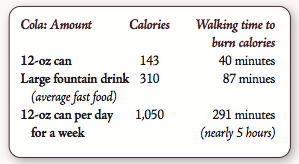Many people are interested in losing extra pounds by changing their food intake in order to reach their goals. Food is a great place to start and, along with exercise, dietary changes can be a powerful influence on your weight and your health overall.
However, when examining their food intake, many people overlook the calories they receive from their beverages. In some cases the amount of “liquid calories” that individuals intake may be sabotaging their weight loss goals.
Health concerns regarding soft drinks —“liquid candy”—have been around for many years. In 1942, the American Medical Association mentioned soft drinks specifically in a strong recommendation to limit intake of added sugar.
At that time, annual U.S. production of carbonated soft drinks was 90 8-oz (240-mL) servings per person. By 2000, this number had risen to more than 600 servings. For some, soft drinks are their main source of liquid intake and are the primary way they are hydrated.
Soft drinks come with very little accompanying nutrition, are high in sugar, and have been shown to displace other nutrient sources from the diet. They have also been linked to a variety of health issues from diabetes to pancreatic cancer. However, many still do not realize the impact these drinks may be having on their health. The calories alone may surprise you.

If your soft drink intake has gotten out of control or is sabotaging your health goals, it may be time to rethink your drink. Water is the ultimate source of hydration. However, if you struggle with drinking water, try to make it fun and interesting. Try adding lemon, lime, or cucumber slices to your cup or water bottle. For more panache, add berries or other fruit to your water. Once these items sit in water for a while, their flavors are infused and create a nice flavor.
If you are ready to start down a healthier path, you may want to start looking at your drinks. Your body will thank you for it!
Republished with permission from the Living Whole Newsletter, Spring 2010. To learn more about the Living Whole Employee Wellness Program, click here.
